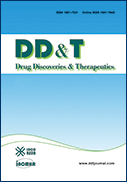Volume 14, Issue 5
Displaying 1-10 of 10 articles from this issue
- |<
- <
- 1
- >
- >|
Review
-
Article type: review-article
2020Volume 14Issue 5 Pages 213-217
Published: October 31, 2020
Released on J-STAGE: November 04, 2020
Advance online publication: October 29, 2020Download PDF (219K)
Original Article
-
Article type: research-article
2020Volume 14Issue 5 Pages 218-225
Published: October 31, 2020
Released on J-STAGE: November 04, 2020
Advance online publication: October 29, 2020Download PDF (1282K) -
Article type: research-article
2020Volume 14Issue 5 Pages 226-231
Published: October 31, 2020
Released on J-STAGE: November 04, 2020
Advance online publication: October 29, 2020Download PDF (451K) -
Article type: research-article
2020Volume 14Issue 5 Pages 232-238
Published: October 31, 2020
Released on J-STAGE: November 04, 2020
Advance online publication: October 29, 2020Download PDF (472K)
Brief Report
-
Article type: brief-report
2020Volume 14Issue 5 Pages 239-242
Published: October 31, 2020
Released on J-STAGE: November 04, 2020
Advance online publication: October 29, 2020Download PDF (472K) -
Article type: brief-report
2020Volume 14Issue 5 Pages 243-248
Published: October 31, 2020
Released on J-STAGE: November 04, 2020
Advance online publication: October 29, 2020Download PDF (1917K)
Case Report
-
Article type: case-report
2020Volume 14Issue 5 Pages 249-251
Published: October 31, 2020
Released on J-STAGE: November 04, 2020
Advance online publication: October 29, 2020Download PDF (828K) -
Article type: case-report
2020Volume 14Issue 5 Pages 252-255
Published: October 31, 2020
Released on J-STAGE: November 04, 2020
Advance online publication: October 29, 2020Download PDF (275K)
Communication
-
2020Volume 14Issue 5 Pages 256-258
Published: October 31, 2020
Released on J-STAGE: November 04, 2020
Advance online publication: October 29, 2020Download PDF (753K) -
2020Volume 14Issue 5 Pages 259-261
Published: October 31, 2020
Released on J-STAGE: November 04, 2020
Advance online publication: October 29, 2020Download PDF (430K)
- |<
- <
- 1
- >
- >|
